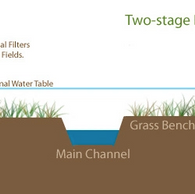FROM FIELD TO FISH – WATER ON THE FARM
- Miranda Acres

- Dec 15, 2016
- 3 min read
We attended an excellent event on field drainage and ditching at our corporate sponsor Spains Hall Essex in Essex this week. Catchment Sensitive Farming, the Environment Agency, the Chelmer and Blackwater Partnership and drainage expert Rob Burtonshaw gave a fascinating series of talks on drainage, ditching, life in water and grants available. This was followed by a great trip out to see the digger from Pearl Drainage in action, and to do some real-life pond dipping!
Field drainage is once again becoming an issue of interest to farmers, with most existing systems being over 50 years old. Some work perfectly, but others have fallen into disrepair leading to reductions in crop yields and water logging. With farm margins under pressure many are considering improving drainage to recover some of their lost yield.
The Water Company view
Steve Derbyshire (Essex and Suffolk Water) and Chelmer and Blackwater Partnership, shared water quality data showing spikes in pesticides entering the rivers recently. He highlighted the effect that Storm Angus had had in washing out pesticides and phosphate nutrients from fields. This costs the company time, effort and money in switching water supplies and treatment to keep our drinking water clean. He highlighted that once pesticides and nutrients are in rivers they aren’t being used for the field pests and crops they had been applied for!
The Drainage Expert
Nuffield Scholar Rob Burtonshaw shared his experiences of a worldwide tour of drainage contractors and highlighted the benefits to both farming and wildlife of appropriately drained fields.
Good soils should be 50% mineral/organic matter, 25% space (air) and 25% water.
Most farmers focus on the 50% that is mineral and organic matter (OM), trying to increase OM, correct the nutrient balance etc;
Roots, water and soil bugs live in the spaces and the water areas;
Good soil structure allows roots to penetrate further, meaning crops are able to access both nutrients and water (in times of drought, for example);
Healthy soils allow water to percolate deeper more quickly, meaning surface flooding and erosion can be reduced;
Roots growing in spaces can access more nutrients, meaning fewer are free to be leached out of the field and into local ditches and watercourses;
Good drainage schemes take the ‘surplus’ field capacity, leaving good air spaces;
Plant roots will actively take more water out of the soil than drainage can achieve – so both need to be considered together;
Use Google Earth to find evidence of field drainage systems if the maps aren’t available;Ditches don’t need to be narrow ‘V’-shaped straight lines – they can be wider, 2-stage, channels which reduce maintenance (with silt being washed away under normal circumstances), whilst large volume flows can still be accommodated. You can see what this looks like below and on this website
Important things to make sure you do before starting ditch maintenance
Check whether the ditch/stream you are working on is ‘main river’ – maps available here (WIMBY). If so then talk to the Environment Agency who will help you apply for the appropriate exemptions.
Essex – contact Matt Butcher
Suffolk – contact Nicola Robinson
If it isn’t main river then talk to your local ‘Lead Flood Authority’ who are probably your local council.
Know what is, or might be, living in the ditch you are planing to work on – are there any species such as Water Voles, Great Crested Newts etc?
Remember, if you disturb protected species, or damage their habitat, then you could be guilty of an offence under the Wildlife and Countryside Act 1981. Definitely not worth the risk! You can always ask the EA, ourselves, or your local Wildlife Trust to help you identify whether this might be an issue.
Make sure you have the appropriate waste exemption – apply for the D1 online here;
Responsible Ditching
There are few things to remember when carrying out the work to make sure you safeguard wildlife and reduce your ongoing maintenance liabilities:
Clean one side only – this helps retain habitat for wildlife but also reduces the risk of erosion in times of high flow
Spread spoil well back from the edge of the ditch – avoid building up an ’embankment’ on the ditch edge
Funding for on-farm pollution and soil-loss reduction works
Catchment Sensitive Farming are once again offering grants to farmers to help improve their pesticide handling and soil management measures, aiming to reduce the amount that ends up in the rivers.














Comments